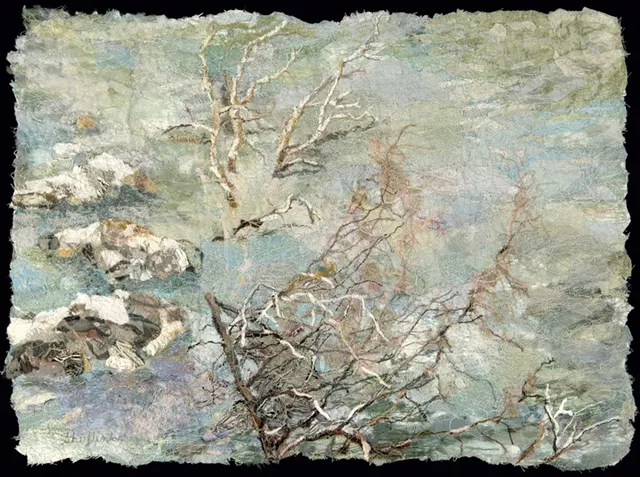It’s fair to say that most of the artists in Vermont focus their efforts on landscapes and still lifes. Many are trying for verisimilitude and achieving it. How, then, to stand out in this aesthetically pleasing crowd?
Dianne Shullenberger of Jericho does it through her medium, creating singular works on familiar subjects using her own style of fabric collage. A selection of them are on view, along with three suites of watercolor paintings, in “Above to Below” at Highland Center for the Arts in Greensboro through April 6.
Shullenberger’s works are collages in that they are composed of many bits of fabric, sewn together. That may not sound unusual, but these are eensy-weensy bits — the scraps that fall off the scissors when something else is being cut out.
Instead of piecing the scraps like a quilt, Shullenberger appliqués them over one another, then sews through the whole mess with a sewing machine. She doesn’t quilt a pattern of stitches: Instead, uneven lengths of thread zigzag across the surface, becoming marks in themselves.
In the 12-by-16-inch “Broken Pine,” Shullenberger offers a view of fallen branches and rocks in a stream. She layers pastel-hued fabrics, using sheer or net materials to create depth and blend color, for a result that looks closer to painting than to collage. The surface is a frenzy of stitches that mimics roiling water. The tree branches dissolve into threads wound through the fabric, seeming to disappear into the stream.
“Sunset” creates a violet-and-peach sky from clumps of silk and tulle, some variegated to look like clouds. Below them, smudgy trees form translucent silhouettes against the bright sky. In works such as “Cornfield Grasses,” Shullenberger uses the fabric’s fraying edges to mimic corn tassels or the edges of leaves. She builds texture sculpturally, creating tangles and twists from slivers of cloth.
In a few pieces, such as “Dried Vines II,” the artist combines fabric and paper. It’s hard to tell where one material ends and the other begins — both have threads running through them. She creates density with fabric, leading the eye with tendrils that extend into paper areas. Those surfaces are literally thinner and read as lighter because of it.
Shullenberger’s watercolors, created during the 2020 COVID-19 lockdown, aren’t as experimental as her fabric works, but they do reveal her love of fiddly detail. Bright colors illuminate the pen drawings, all of which are 6 by 6 inches.
They’re cartoonlike in their style. “Notes” shows a desk overflowing with Post-it reminders of half-readable quotes, and others feature pincushions or tubs of yarn. Even in these works, executed in a more conventional medium, chaotic scraps pile up to create a comprehensive — and quite aesthetically pleasing — whole.

